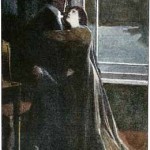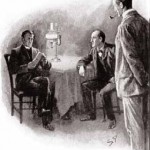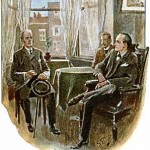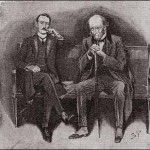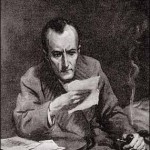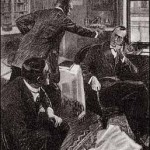We had a pleasant little meal together, during which Holmes would talk about nothing but violins, narrating with great exultation how he had purchased his own Stradivarius, which was worth at least five hundred guineas, at a Jew broker’s in Tottenham Court Road for fifty-five shillings. This led him to Paganini, and we sat for an hour over a bottle of claret while he told me anecdote after anecdote of that extraordinary man. The afternoon was far advanced and the hot glare had softened into a mellow glow before we found ourselves at the police-station. Lestrade was waiting for us at the door.
“A telegram for you, Mr. Holmes,” said he.
“Ha! It is the answer!” He tore it open, glanced his eyes over it, and crumpled it into his pocket. “That’s all right,” said he.
“Have you found out anything?”
“I have found out everything!”
“What!” Lestrade stared at him in amazement. “You are joking.”
“I was never more serious in my life. A shocking crime has been committed, and I think I have now laid bare every detail of it.”
“And the criminal?”
Holmes scribbled a few words upon the back of one of his visiting cards and threw it over to Lestrade.
“That is the name,” he said. “You cannot effect an arrest until to-morrow night at the earliest. I should prefer that you do not mention my name at all in connection with the case, as I choose to be only associated with those crimes which present some difficulty in their solution. Come on, Watson.” We strode off together to the station, leaving Lestrade still staring with a delighted face at the card which Holmes had thrown him.
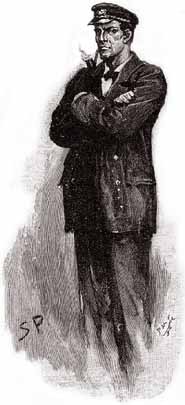
“The case,” said Sherlock Holmes as we chatted over our cigars that night in our rooms at Baker Street, “is one where, as in the investigations which you have chronicled under the names of ‘A Study in Scarlet’ and of ‘The Sign of Four,’ we have been compelled to reason backward from effects to causes. I have written to Lestrade asking him to supply us with the details which are now wanting, and which he will only get after he had secured his man. That he may be safely trusted to do, for although he is absolutely devoid of reason, he is as tenacious as a bulldog when he once understands what he has to do, and indeed, it is just this tenacity which has brought him to the top at Scotland Yard.”
“Your case is not complete, then?” I asked.
“It is fairly complete in essentials. We know who the author of the revolting business is, although one of the victims still escapes us. Of course, you have formed your own conclusions.”
“I presume that this Jim Browner, the steward of a Liverpool boat, is the man whom you suspect?”
“Oh! it is more than a suspicion.”
“And yet I cannot see anything save very vague indications.”
“On the contrary, to my mind nothing could be more clear. Let me run over the principal steps. We approached the case, you remember, with an absolutely blank mind, which is always an advantage. We had formed no theories. We were simply there to observe and to draw inferences from our observations. What did we see first? A very placid and respectable lady, who seemed quite innocent of any secret, and a portrait which showed me that she had two younger sisters. It instantly flashed across my mind that the box might have been meant for one of these. I set the idea aside as one which could be disproved or confirmed at our leisure. Then we went to the garden, as you remember, and we saw the very singular contents of the little yellow box.
“The string was of the quality which is used by sail-makers aboard ship, and at once a whiff of the sea was perceptible in our investigation. When I observed that the knot was one which is popular with sailors, that the parcel had been posted at a port, and that the male ear was pierced for an earring which is so much more common among sailors than landsmen, I was quite certain that all the actors in the tragedy were to be found among our seafaring classes.
“When I came to examine the address of the packet I observed that it was to Miss S. Cushing. Now, the oldest sister would, of course, be Miss Cushing, and although her initial was ‘S’ it might belong to one of the others as well. In that case we should have to commence our investigation from a fresh basis altogether. I therefore went into the house with the intention of clearing up this point. I was about to assure Miss Cushing that I was convinced that a mistake had been made when you may remember that I came suddenly to a stop. The fact was that I had just seen something which filled me with surprise and at the same time narrowed the field of our inquiry immensely.
“As a medical man, you are aware, Watson, that there is no part of the body which varies so much as the human ear. Each ear is as a rule quite distinctive and differs from all other ones. In last year’s Anthropological Journal you will find two short monographs from my pen upon the subject. I had, therefore, examined the ears in the box with the eyes of an expert and had carefully noted their anatomical peculiarities. Imagine my surprise, then, when on looking at Miss Cushing I perceived that her ear corresponded exactly with the female ear which I had just inspected. The matter was entirely beyond coincidence. There was the same shortening of the pinna, the same broad curve of the upper lobe, the same convolution of the inner cartilage. In all essentials it was the same ear.

